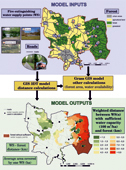
International Journal of Wildland Fire
Volume 30 Number 6 2021
WF20127Traditional use of field burning in Ireland: history, culture and contemporary practice in the uplands
Intergenerational field burning practices in Ireland are increasingly under threat from changing policy and public concerns about wildfire risk. We investigate how burning practices are conducted and how knowledge of this practice is preserved through focus groups with 60 Irish farmers before providing suggestions for future partnerships to overcome current challenges to fire use.
WF20127 Abstract | WF20127 Full Text | WF20127PDF (162 KB) Open Access Article
Wildfire simulations require high-resolution wind data to resolve terrain effects, but this is usually only available at coarse scales. We introduce a fast, simple downscaling method that produces comparable results to current methods. The method can be directly coupled to wildfire models allowing dynamic wind–terrain interactions to be modelled.
WF20103A simple model indicates that there are sufficient water supply points for fighting forest fires in the Czech Republic

A main requirement for extinguishing large forest fires is the availability of water supply points. We determined whether the Czech Republic has enough water to fight forest fires and whether these water supply points are distributed so that all forest stands will have enough water nearby to fight fires.
WF20103 Abstract | WF20103 Full Text | WF20103PDF (1.6 MB) Open Access Article
In this study, a physics-based computational model is built to simulate self-heating ignition of natural peat layers. According to the simulations, for a 1.5-m-deep peat layer, self-heating ignition can occur at an ambient temperature of 40°C. The simulations show that it is possible for wildfires to be initiated by self-heating in some conditions.
WF20155How to build a firebreak to stop smouldering peat fire: insights from a laboratory-scale study
Firebreaks are constructed to isolate wildfires and protect humans and properties. This work explores the feasibility of firebreaks in controlling smouldering peat fires and details their scientific construction criteria.
As fuel moisture affects fuel ignition potential and fire behaviour, this study was aimed to determine whether vapour-exchange methods could be used for determining hourly twig fuel moisture content in larch and birch twigs in the Daxinganling Region, China, which is adversely impacted by frequent forest fires.
WF20094Using a biomathematical model to assess fatigue risk and scheduling characteristics in Canadian wildland firefighters
 , Hugh W. Davies, Shannon S. D. Bredin, Andrew S. Perrotta, Benjamin A. Hives
, Hugh W. Davies, Shannon S. D. Bredin, Andrew S. Perrotta, Benjamin A. Hives  , Leah Meanwell and Darren E. R. Warburton
, Leah Meanwell and Darren E. R. Warburton
We examined the shift parameters that contribute to sleep loss and on-duty fatigue in Canadian wildland firefighters using recorded sleep–wake data, work–rest data and alertness and fatigue predictions from a biomathematical model of fatigue. Shift duration was the major contributor to fatigue, although none of the firefighters had on-duty fatigue scores that were considered high risk.



